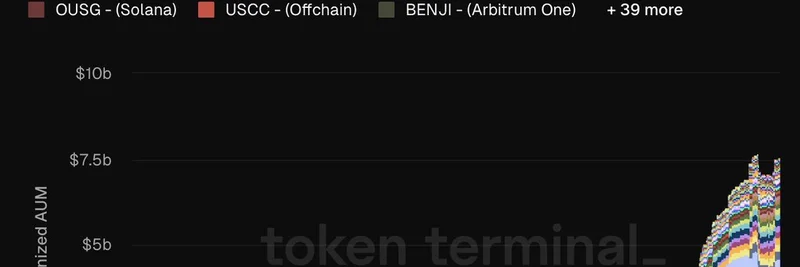If you're into blockchain and crypto, you've probably noticed how stablecoins like USDT and USDC pretty much own their space. But when it comes to tokenized funds—think real-world assets like treasury bills wrapped up on the blockchain—the game is way more open. A recent chart from Token Terminal on X highlights this shift, showing tokenized assets under management (AUM) soaring to around $10 billion by mid-2025.
Breaking Down the Chart
The visualization breaks out AUM by individual funds, with colors representing different products across chains like Ethereum, Solana, Polygon, and even offchain or Arbitrum. At the top? BlackRock's BUIDL on Ethereum, clocking in as the heavyweight with its light green slice. Right behind are funds like WTGXX (also Ethereum), OUSG, and USDY.
What's cool is the diversity here. Unlike stablecoins where two players dominate, tokenized funds feature a mix:
- Ethereum-based funds like BUIDL, WTGXX, OUSG, USDY, and USCC leading the pack.
- Solana entries such as USDY-Solana and OUSG-Solana adding competition.
- Niche players like Spiko's EUTBL on Arbitrum One and Polygon, which stands out as the first tokenized money market fund (TMMF) investing in EU Treasury Bills.
The stacked area graph at the bottom tracks growth from early 2023, starting near zero and climbing steadily to that $10B mark by July 2025. It's a clear sign that tokenization of traditional finance products is gaining serious traction.
Why This Matters for Blockchain Enthusiasts
Tokenized funds are essentially bridges between TradFi (traditional finance) and DeFi (decentralized finance). They let you hold assets like money market funds or treasury bills on-chain, earning yields while enjoying blockchain perks like instant transfers and composability. For instance, a tokenized treasury bill can be used as collateral in DeFi protocols, potentially boosting liquidity for everything from stablecoin lending to—yes—even meme token ecosystems.
Speaking of memes, while these funds are more about stability than viral hype, they could indirectly fuel meme token plays. Imagine meme projects integrating with these yield-bearing assets for treasury management or community incentives. As blockchain practitioners, keeping an eye on this helps you spot opportunities where low-vol assets support high-vol fun like memes.
The Competitive Edge Over Stablecoins
Token Terminal's point is spot-on: stablecoins are a duopoly, with Tether's USDT and Circle's USDC holding over 80% of the market. Tokenized funds? Much more fragmented, with no single fund owning more than a chunk of the pie. This even distribution could spark innovation—more chains, more products, better yields for users.
Funds like TBILL (Ethereum) or BENJI (Arbitrum One) show how projects are experimenting across layers. And with +39 more funds mentioned, the space is exploding. If you're building or investing in blockchain, this data from the original X post is a reminder to diversify beyond stables.
Looking Ahead
As we hit late 2025, expect tokenized AUM to keep growing. Regulatory nods, like those for BlackRock's BUIDL, are paving the way. For meme token fans and DeFi degens alike, this means more on-ramps for real-world value into crypto. Stay tuned—Token Terminal's dashboards are a goldmine for tracking this.
If you're diving deeper into meme tokens or blockchain tech, check out our knowledge base here at Meme Insider for more insights.


